The culinary world is vast, and sometimes, while in the midst of cooking, we find ourselves without a crucial ingredient. Leeks, for example, are a wonderful addition to many recipes. But what if you don’t have them on hand? Fortunately, there are plenty of leek substitutes that can save the day.
This post contains affiliate links.
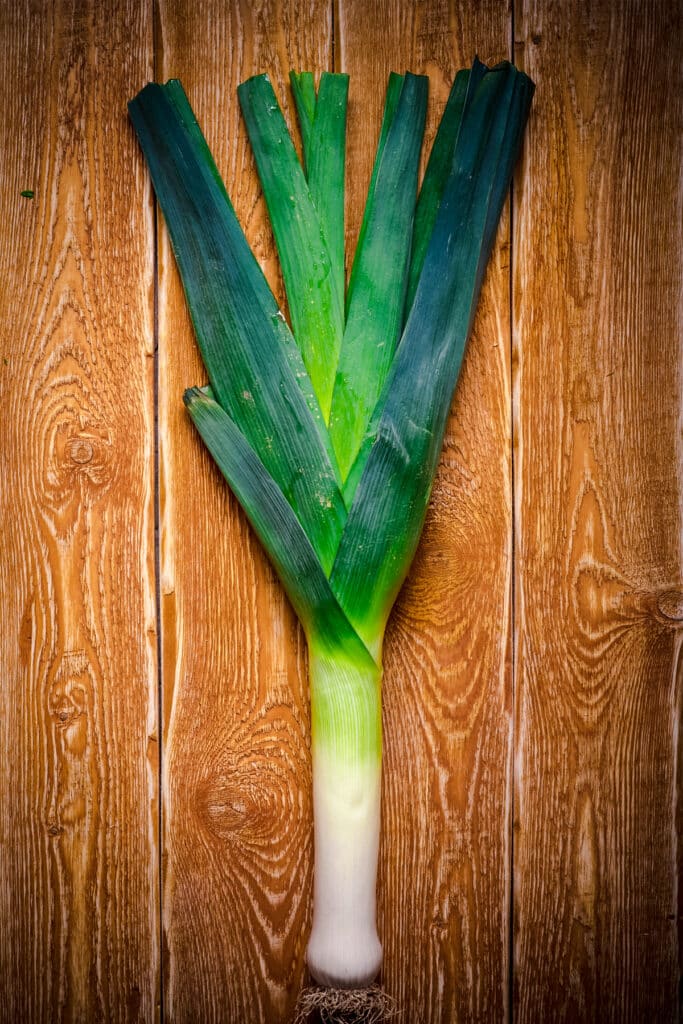
What are leeks?
What are leeks? These members of the Allium family, closely related to onions, garlic, and shallots, are characterized by their long cylindrical shape with tightly packed white stalks and green leaves.
Originating from Central Asia, they’ve become integral in global cuisines. Leeks possess a milder flavor compared to the stronger taste of regular onions, making them the main ingredient in various recipes.
When cooked, they offer a delicate, slightly sweet taste, akin to a blend between mild sweet onions and garlic. Known for their versatility, you can find them sautéed in olive oil, boiled, or even grilled. While the white and light green portions are popularly consumed, the tougher green leaves can also be incorporated at the end of the cooking time in broths or stocks.
Health Benefits Of Leeks
Leeks, while often overshadowed by their more popular Allium family members like onions and garlic, offer a multitude of health benefits. Here are some reasons to incorporate leeks into your diet:
Leeks are a good source of essential vitamins and minerals, including vitamin A, vitamin C, vitamin K, and B vitamins. They also provide iron, manganese, and folate, which are crucial for various bodily functions. The flavonoids and polyphenols in leeks have antioxidant properties that help combat oxidative stress, reducing the risk of chronic diseases. The dietary fiber in leeks can help improve digestive health. Fiber adds bulk to the diet, aids in bowel regularity, and supports overall gut health.
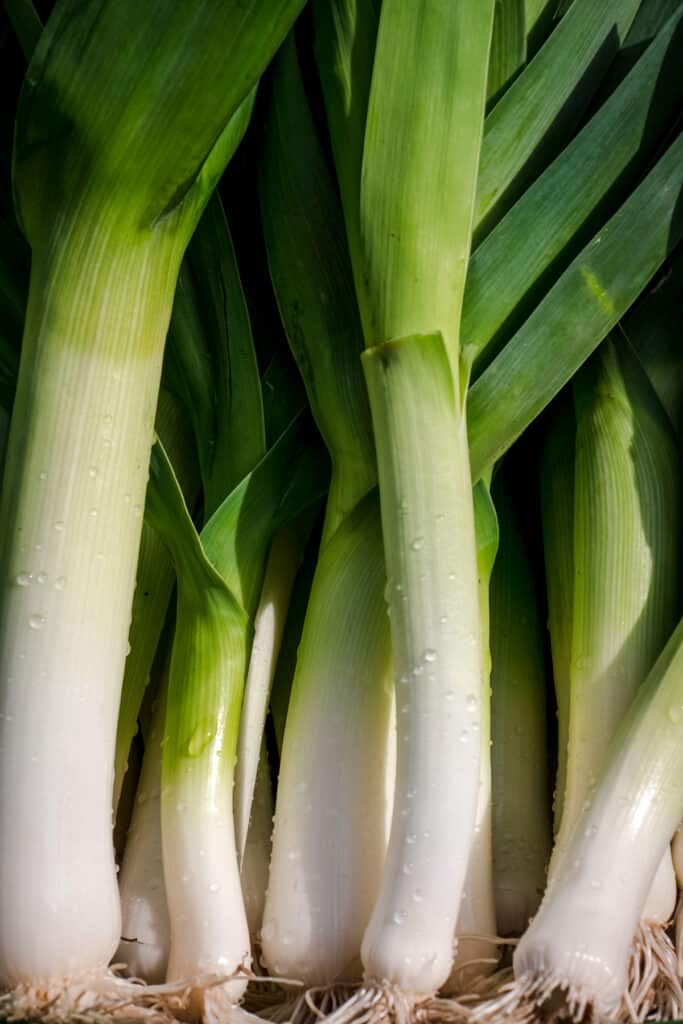
Considerations For Substituting Leeks
Substituting leeks in your dish requires a keen sense of the desired outcome in terms of flavor and texture. While leeks have a milder taste, introducing a leek substitute with a stronger flavor, like spring onions or garlic, might dominate the dish.
For the best results, it’s imperative to select a leek replacement that mirrors the taste and texture of leeks. If raw leek is your main ingredient, a good alternative might be green onions (scallions). Their mild, oniony profile is somewhat similar, though they possess a slightly stronger taste. Wild ramps or wild leeks, available in some grocery stores, are another good replacement, especially if you’re aiming for a type of onion flavor but with a punchier taste.
The cooking times and amounts might differ when using a substitute. For instance, while fresh leeks might require longer cooking times due to their firm texture, spring onions or scallions, being more tender, require shorter durations. Moreover, if your recipe calls for a cup of leeks, you might need smaller amounts of a stronger-tasting substitute to achieve a similar flavor. Whether it’s for a potato soup or a stir-fry, always keep the desired taste, texture, and cooking time in mind while choosing the best leek substitute.
While this post has several leek substitutes, remember that some dishes might yield the best results with the original ingredient, leeks. But in a pinch, knowing these alternatives can save a recipe. However, in some cases, simply omitting the leek from your recipe is the best option. Happy cooking!
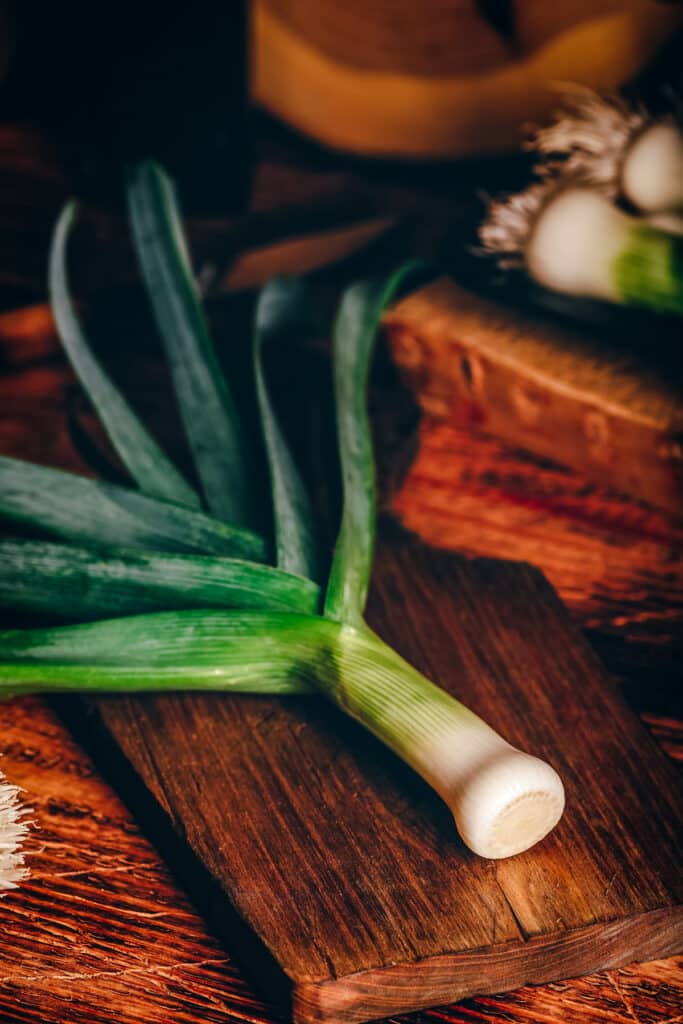
The List: 20 Best Leek Substitutes
When you’re in the middle of a recipe and realize you’re out of leeks, don’t panic! Here’s a comprehensive guide to the 20 best leek substitutes that can save your dish and add a unique twist.
- Leek Powder
Derived from dried and ground leeks, leek powder captures the mild, onion-like flavor of its fresh counterpart. It’s a convenient way to infuse dishes with a leek essence, particularly in soups, stews, and spice rubs.
Recommended ratio: For a recipe that calls for one large leek (or 1 cup chopped leek), use one teaspoon of leek powder. - Wild Leeks (Validallium tricoccum)
Also called ramps, are a wild relative of leeks and possess a more pronounced and pungent flavor. Often foraged in the spring, they’re popular in various dishes, from stir-fries to pickles, and are celebrated for their bold, garlicky undertones.
Recommended ratio: For a recipe that calls for one large leek (or 1 cup chopped leek), use four or more wild leeks. (Keep in mind that wild leeks are much smaller than store-bought leeks.) - Green Onions (Scallions)
Scallions offer a slightly sharper taste compared to leeks but remain close in their mild onion profile. They’re versatile and can be used both raw in salads and salsas or cooked in stir-fries and soups.
Recommended ratio: For a recipe that calls for one large leek (or 1 cup chopped leek), use six to eight medium green onions.
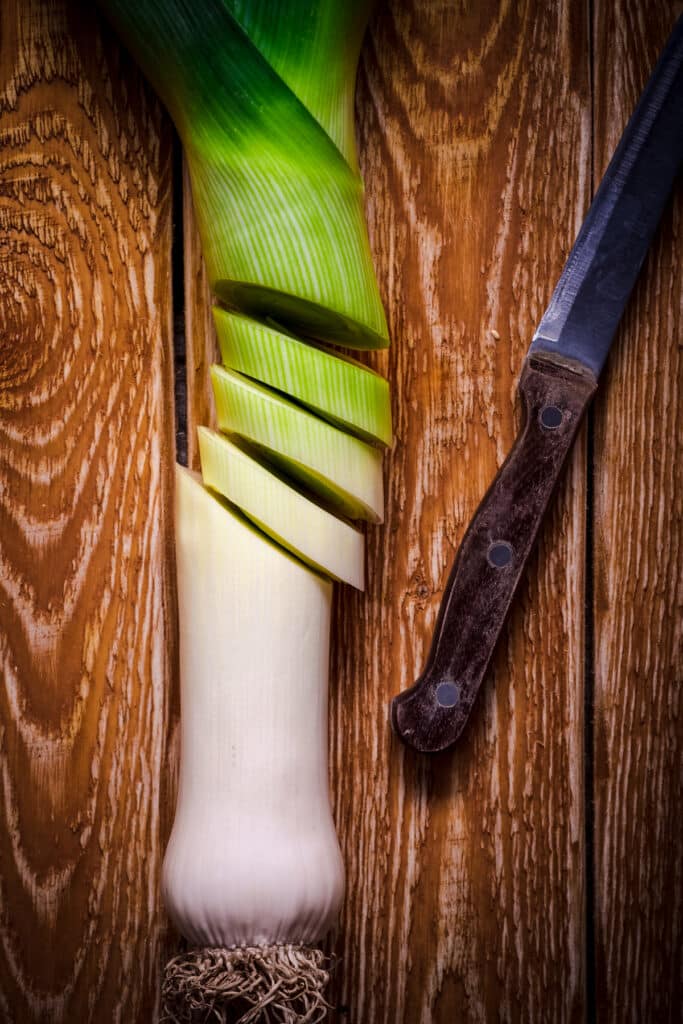
- Calçot
A Calcot is a type of scallion native to Catalonia, Spain. Resembling an oversized green onion but with a milder and sweeter flavor, calçots are traditionally grilled until charred, then wrapped in newspaper to steam. While calcots have their unique taste and cultural significance, especially in the Calcotada festival, their sweet and mild onion flavor can make them a potential substitute for leeks in various recipes.
Recommended ratio: For a recipe that calls for one large leek (or 1 cup chopped leek), use six to eight medium calçots. - Chives
These delicate green herbs offer a gentle, oniony touch. Best used fresh, they’re a classic garnish for soups, baked potatoes, and salads.
Recommended ratio: For a recipe that calls for one large leek (or 1 cup chopped leek), use one tablespoon of chopped chives. - Shallots
With their delicate and slightly sweet flavor, shallots are often used in sauces, dressings, and sautés. They add a nuanced depth without overpowering a dish.
Recommended ratio: For a recipe that calls for one large leek (or 1 cup chopped leek), use 2 large shallots or 3 medium shallots. - Yellow Onions
These are the workhorses of the kitchen, with a robust flavor that softens and sweetens upon cooking. They form the base for countless dishes worldwide, from curries to casseroles.
Recommended ratio: For a recipe that calls for one large leek (or 1 cup chopped leek), use one small yellow onion in its place.
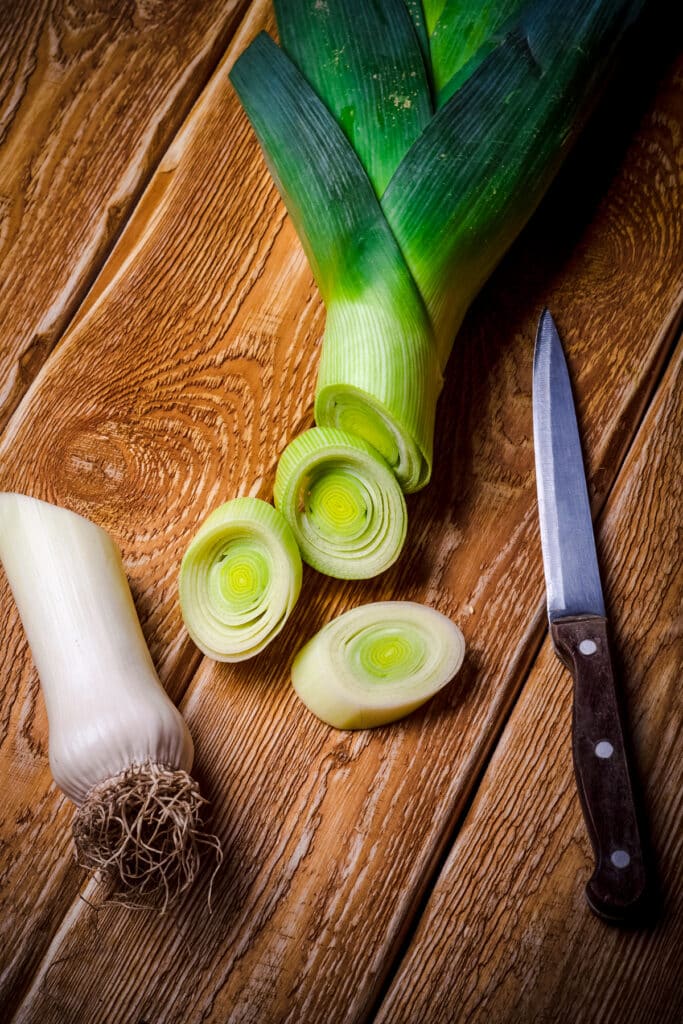
- White Onions
Known for their crisp texture and light flavor, white onions are often consumed raw, making them perfect for salsas, salads, and sandwiches.
Recommended ratio: For a recipe that calls for one large leek (or 1 cup chopped leek), use one small white onion. Remember, leeks tend to be milk in flavor, whereas onions are packed! - Sweet Onions
Living up to their name, these onions are less pungent and have a natural sweetness. They caramelize beautifully, making them ideal for roasting or grilling.
Recommended ratio: For a recipe that calls for one large leek (or 1 cup chopped leek), use one medium sweet onion. Remember that leeks tend to be milk in flavor, whereas onions are not. - Red Onions
Recognized for their vibrant color and zesty flavor, red onions are best when sautéed, caramelized, or even raw, adding a punch to salads.
Recommended ratio: For a recipe that calls for one large leek (or 1 cup chopped leek), use one small red onion or half of a larger red onion. - Onion Powder
This is dried, ground onion and is a staple in many spice cabinets. It offers a quick way to impart onion flavor to dishes without the bulk or moisture.
Recommended ratio: For a recipe that calls for one large leek (or 1 cup chopped leek), use one teaspoon of onion powder.
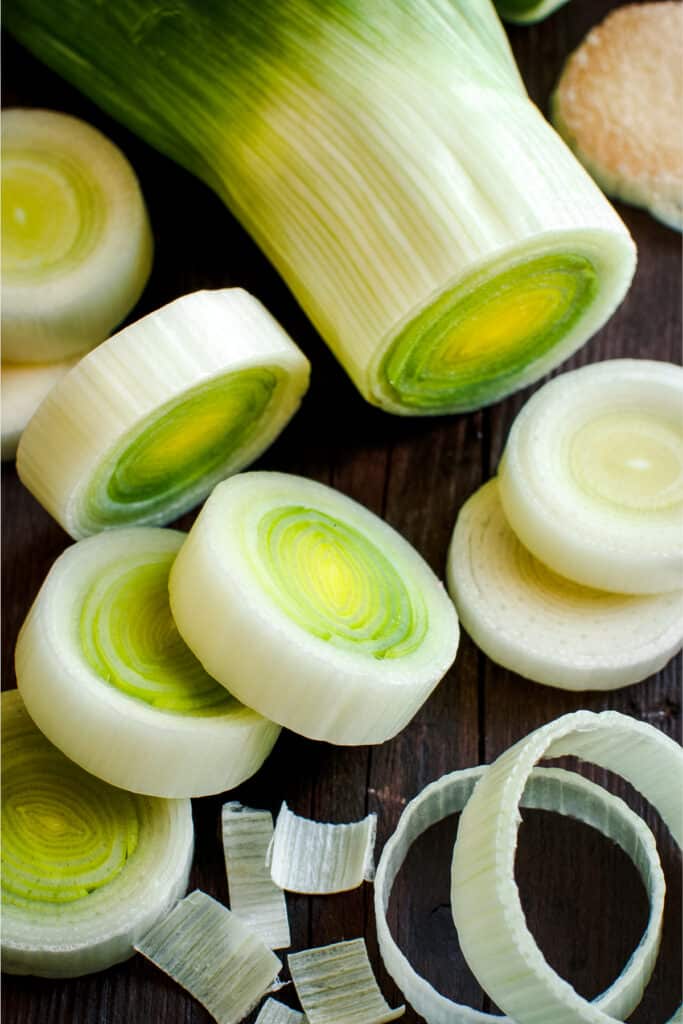
- Wild Garlic (Allium ursinum)
Wild garlic, also known as bear’s garlic or ramsons, is a fragrant, leafy green plant that grows in woodlands during the spring. Its broad leaves are similar in appearance to a lily of the valley but can be distinguished by their strong garlic scent. Both the leaves and the bulb of wild garlic can be eaten, and they are often used in salads, soups, and as a garnish. Its pungent aroma and flavor make it a sought-after ingredient for gourmet dishes and traditional recipes alike.
Recommended ratio: For a recipe that calls for one large leek (or 1 cup chopped leek), use four or more wild garlic. (Keep in mind that wild leeks are much smaller than store-bought leeks.) - Garlic Scapes
The tender shoots of the garlic plant. Garlic scapes boast a milder garlic flavor. They’re often chopped into stir-fries, made into pesto, or pickled.
Recommended ratio: For a recipe that calls for one large leek (or 1 cup chopped leek), use about four garlic scapes. - Fresh Garlic
A cornerstone in many cuisines, fresh garlic introduces a strong, pungent flavor. Its taste and intensity can transform based on its preparation, from sharp when raw to mellow and sweet when roasted.
Recommended ratio: Start out small with one clove minced for each leek called for in the recipe. - Fresh Elephant Garlic
This variant of garlic is milder and larger in size. With its sweeter taste, it’s great roasted whole or used in dishes where a softer garlic touch is desired.
Recommended ratio: For a recipe that calls for one large leek (or 1 cup chopped leek), use one teaspoon of minced elephant garlic.
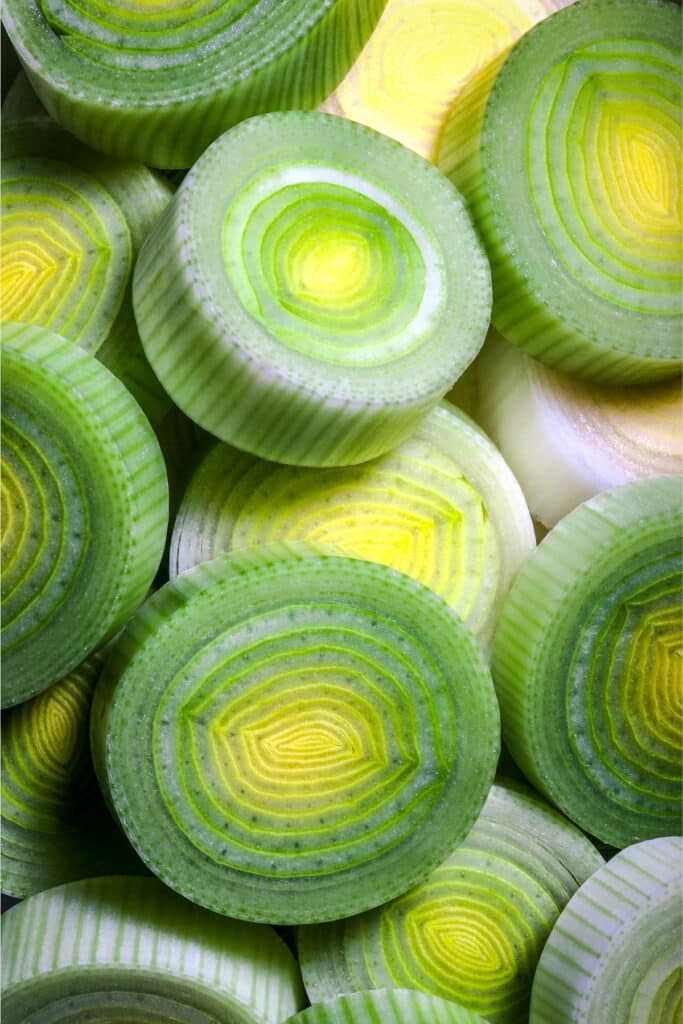
- Garlic Powder
Made from ground dried garlic, this is a kitchen staple for those looking to introduce a hint of garlic flavor without the preparation or intensity of fresh garlic.
Recommended ratio: For a recipe that calls for one large leek (or 1 cup chopped leek), use one teaspoon of garlic powder. - Fennel Bulb
With its unique licorice flavor, the fennel bulb can be eaten raw in salads, braised, or roasted. It pairs beautifully with fish and often forms part of Mediterranean cuisine. With its unique flavor, it may not be the best option for the recipe you are making.
Recommended ratio: For a recipe that calls for one large leek (or one cup of chopped leek), use one-quarter to half of a bulb. - Celery
Celery is a crisp vegetable with a distinct fresh and slightly peppery flavor. While its taste is different from leeks, its crunchy texture can make it a useful substitute in dishes that require a bit of bite. It’s often used in soups, stews, and stir-fries.
Recommended ratio: For a recipe that calls for one large leek (or one cup of chopped leek), use two stalks of celery. - Celery Leaves
Often overlooked, celery leaves carry a more concentrated flavor compared to the stalks. They can add a herbaceous and slightly bitter note to dishes, making them suitable as a garnish or as an ingredient in soups where leek’s mild flavor needs a stand-in.
Recommended ratio: For a recipe that calls for one large leek (or 1 cup chopped leek), use one cup of celery leaves. - Bok Choy
Also known as Chinese cabbage, bok choy has a mild, slightly peppery taste with a hint of mustard. Its white stems resemble celery in crunch and moisture, while the leafy greens are tender. In recipes that require leeks for texture and a hint of onion-like flavor, bok choy can serve as a unique substitute, especially in Asian dishes.
Recommended ratio: For a recipe that calls for one large leek (or 1 cup chopped leek), use
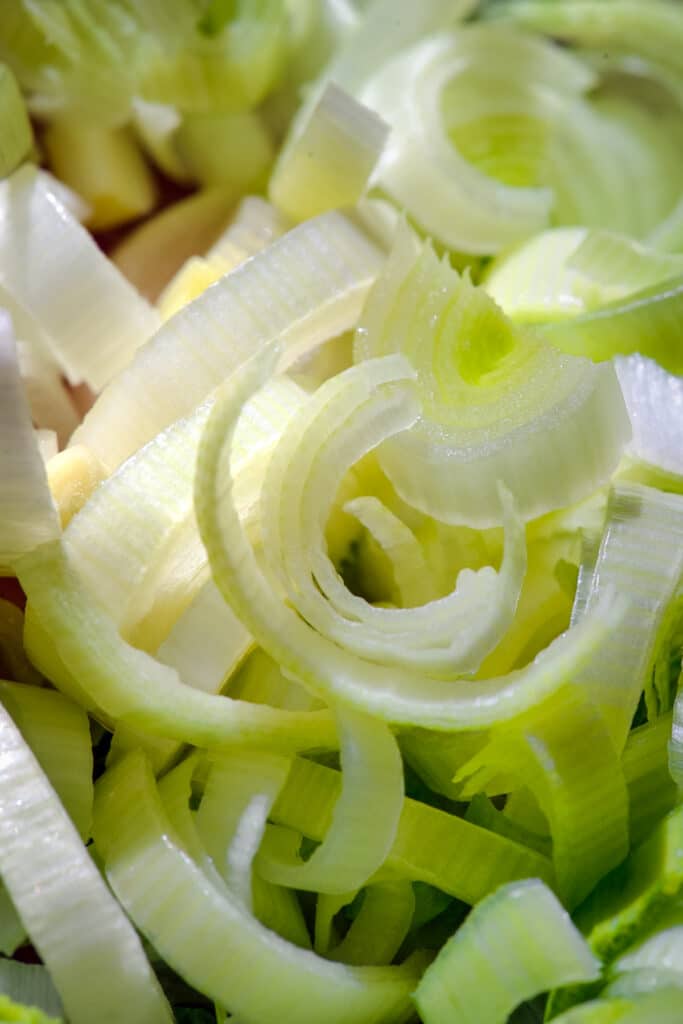
Have you ever tried potato leek soup? This is my favorite potato leek soup recipe!
How To Prepare Leeks
Leeks, with their subtle onion-like flavor, can elevate many dishes, but they require a bit of care in preparation. Here’s a step-by-step guide on how to prepare leeks to get the best out of this versatile vegetable.
- Cleaning: Cut off the dark green parts and the very end of the root. Slice the leek in half lengthwise and wash thoroughly to remove any sand or dirt.
- Chopping: Depending on your recipe, you can slice them into rings or chop them finely.
- Cooking: Leeks can be sautéed, boiled, roasted, or even grilled.
Ready to prep your veggies?
Here are my favorite knives for prepping veggies.
FAQ
While tougher than the white part, the green portion can be used for making stocks or added to soups if chopped finely.
Keep them in the refrigerator, wrapped in a damp paper towel, and placed in a plastic bag.
Yes, you can substitute leeks for onions in many recipes. However, leeks have a milder and more delicate flavor than most onions, so the taste of the dish might be slightly different. The white and light green parts of the leek are the most commonly used for this purpose.
Leeks belong to the Allium family, which includes other vegetables like onions, garlic, shallots, and chives. All these vegetables share certain flavor characteristics and are closely related.
Yes, leeks and onions have a similar taste profile, as they both belong to the Allium family. However, leeks are milder and less pungent than onions, with a slightly sweeter and more delicate flavor. The taste of leeks can be described as a blend between onions and garlic.
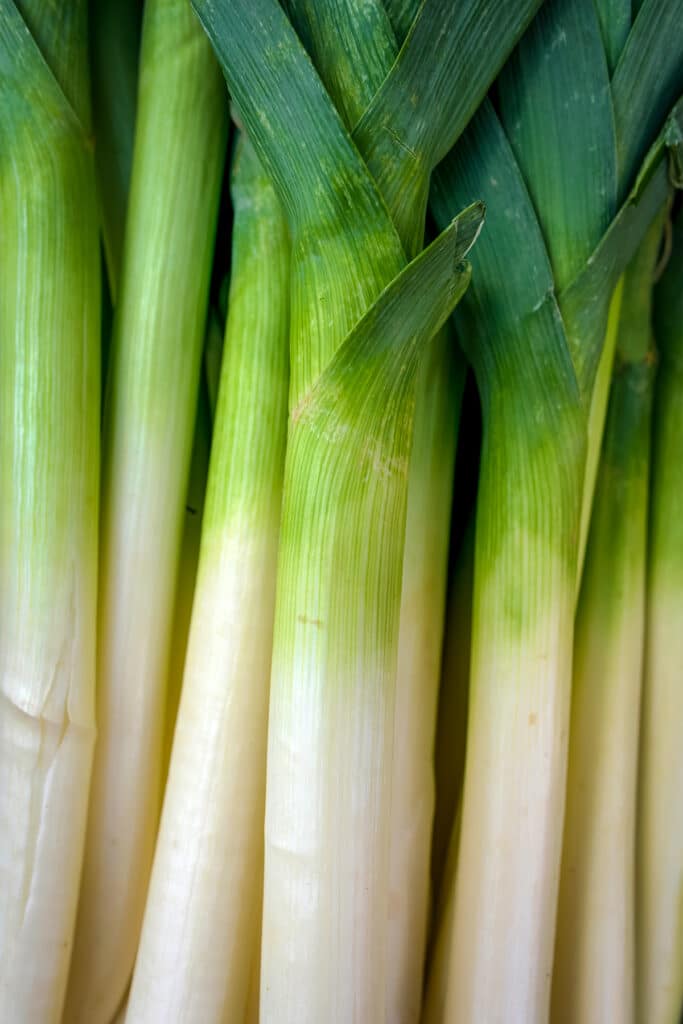
Final Words
While leeks bring a distinct flavor to dishes, there’s no need to panic if you’re out of them. Many substitutes can offer a similar taste profile, ensuring your recipes remain delicious and flavorful. Whether you opt for green onions, shallots, or any of the other substitutes listed, your dish is sure to be a hit!
Looking For More Ingredient Substitutions?
Whether you are making one of your staple recipes or trying out a new one, sometimes you just don’t have the right ingredients on hand. Next time you are in a pickle, check out these helpful resources.
This post may contain affiliate links, meaning I’ll receive a commission if you purchase through those links at no extra cost to you. Please read our full disclosure for more information. Thank you for supporting Raepublic.



Love these substitutions. I often just omit if I don’t have something suitable on hand.
Thats usually a safe bet!